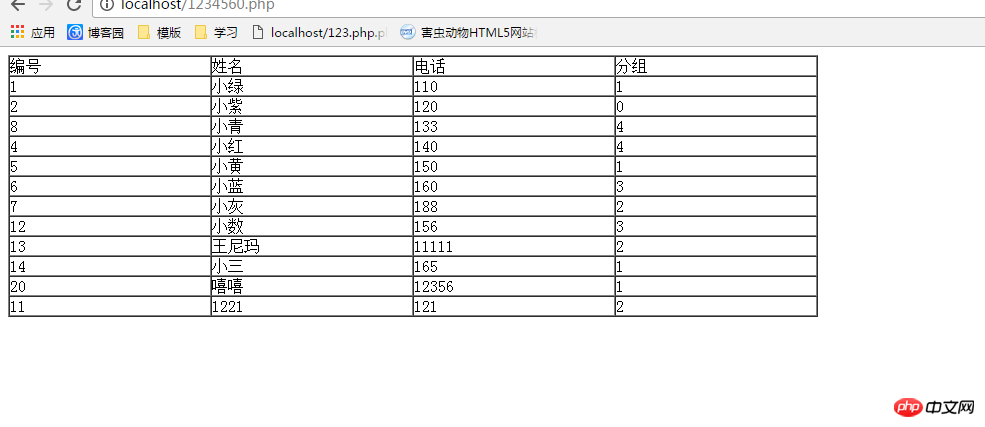Home >Backend Development >PHP Tutorial >How to implement conditional query in php+mysql? (code example)
How to implement conditional query in php+mysql? (code example)
- 怪我咯Original
- 2018-05-14 14:33:3924579browse
How to implement multi-conditions in SQL query fields: first connect to the database; then use SQl's "select from...WHERE...." statement to perform single-condition and multi-condition queries on the database.

What this article shares with you is the code and examples of using php+mysql to implement single-condition and multi-condition queries. It is very practical. Friends in need can refer to it. Recommended
related mysql video tutorials: "mysql tutorial"
Single condition query:
1. First there must be a A table showing the data in the table:
<!DOCTYPE html PUBLIC "-//W3C//DTD XHTML 1.0 Transitional//EN" "http://www.w3.org/TR/xhtml1/DTD/xhtml1-transitional.dtd">
<html xmlns="http://www.w3.org/1999/xhtml">
<head>
<meta http-equiv="Content-Type" content="text/html; charset=utf-8" />
<title>无标题文档</title>
</head>
<body>
<table border="1" cellspacing="0" cellpadding="0">
<tr>
<td width="200">编号</td>
<td width="200">姓名</td>
<td width="200">电话</td>
<td width="200" >分组</td>
</tr>
<?php
$db = new mysqli("localhost","root","12345678","heiheihei");
$sql = "select * from contacts";
$r = $db->query($sql);
//传值
while ($attr = $r->fetch_row())
{
echo " <tr>
<td>{$attr[0]}</td>
<td>{$attr[1]}</td>
<td>{$attr[2]}</td>
<td>{$attr[3]}</td>
</tr>";
}
?>
</table>
</body>
</html>Above picture:

A table without any changes
2 .Let the user enter another from form and click to query:
<form action="shouye.php" method="post">
<p>
输入名字:<input type="text" name="name"/>
<input type="submit" value="查询"/>
</p>
</form>As shown in the picture:

3. Create a keyword query:
<?php
//实现两个逻辑
//1.如果没有post数据.查所有的
//2.如果有post数据.根据条件查
$db = new mysqli("localhost","root","12345678","heiheihei");
//连接数据库
$tj = " 1 = 1 ";
$name="";
//恒成立,如果没有写数据,那就让条件等于1=1,这个条件是查找所有的数据
//如果你写入数据,按照数据查
if(!empty($_POST))
{
$name = $_POST['name'];
$tj = " name like '%{$name}%'";
}
//将条件拼接到SQl语句
$sql = "select * from contacts WHERE {$tj}";
echo $sql;
//查出来
$r = $db->query($sql);
//传值
if($r)
//开始判断
{
//$attr已经接收到了值,现在只需要获取他的索引就行了
while ($attr = $r->fetch_row())
{
//关键字特殊查询
$str = str_replace($name,"<mark>{$name}</mark>",$attr[1]); //查找替换如ctrl+f
//substr_replace(); 在指定位置替换
//substr(); 截取字符串
$gname = "select gname from groups WHERE gid='{$attr[3]}'";
//分组表中的gid,和我点击的
$nresult = $db->query($gname);
$gname = $nresult->fetch_row();
$nation = $gname[0];
echo " <tr>
<td>{$attr[0]}</td>
<td>{$str}</td>
<td>{$attr[2]}</td>
<td>{$nation}</td>
?>Picture:

Multi-condition query:
The same as before;
The php statement:
<?php
//实现两个逻辑
//1.如果没有post数据.查所有的
//2.如果有post数据.根据条件查
$db = new mysqli("localhost","root","12345678","heiheihei");
//连接数据库
$tj1 = " 1 = 1 ";
$tj2 = " 1 = 1 ";//两个条件的恒等
$name="";
//恒成立,如果没有写数据,那就让条件等于1=1,这个条件是查找所有的数据
//如果你写入数据,按照数据查
if(!empty($_POST["name"])) //第一个条件的判断(用到了模糊查询)
{
$name = $_POST['name'];
$tj1 = " name like '%{$name}%'";
}
if(!empty($_POST["tel"]))
{
$tel = $_POST["tel"];
$tj2 = "tel = '$tel'";
}
//将条件拼接到SQl语句
$sql = "select * from contacts WHERE {$tj1} AND {$tj2}";Rendering:

This way: if there are several conditions, make several condition variables. If the first condition is not empty, the first condition will be executed, and the second condition will be executed. The second condition is executed if the condition is not empty. If both are empty, all data is searched
The above is the detailed content of How to implement conditional query in php+mysql? (code example). For more information, please follow other related articles on the PHP Chinese website!

